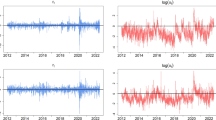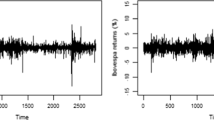Abstract
For financial volatilities such as realized volatility and volatility index, a new parametric quantile forecast strategy is proposed, focusing on forecast interval and value at risk (VaR) forecast. This fully addresses asymmetries in 3 parts: mean, volatility and distribution. The asymmetries are addressed by the LHAR (leverage heterogeneous autoregressive) model of McAleer and Medeiros (2008) and Corsi and Reno (2009) for the mean part, by the EGARCH model for the volatility part, and by the skew-t distribution for the error distribution part. The method is applied to the realized volatilities and the volatility indexes of the US S&P 500 index, the US NASDAQ index, the Korea KOSPI index in which significant asymmetries are identified. Considerable out-of-sample forecast improvements of the forecast interval and VaR forecast are demonstrated for the volatilities: forecast intervals of volatilities have better coverages with shorter lengths and VaR forecasts of volatility indexes have better violations if asymmetries are properly addressed rather than ignored. The proposed parametric method reveals considerably better out-of-sample performance than the recently proposed semiparametric quantile regression approach of Zikes and Barunik(2016).
Similar content being viewed by others
References
Alberg, D., Shalit, H., & Yosef, R.(2008). Estimating stock market volatility using asymmetric GARCH models. Applied Financial Economics, 18, 1201–1208.
Alexander, C., Kapraun, J., & Korovilas, D.(2015). Trading and investing in volatility products. Financial Markets, Institution & Instruments, 24, 313–347.
Andersen, T. G., Bollerslev, T., Diebold, F. X., & Labys, P.(1999). The distribution of exchange rate volatility. Journal of the American Statistical Association, 96, 42–55.
Andersen, T. C., Bollerslev, T., Diebold, F. X., & Labys, P.(2001). The distribution of realized exchange rate volatility. Journal of the American Statistical Association, 96, 42–55.
Andersen, T. C., Bollerslev, T., Diebold, F. X., & Labys, P.(2003). Modeling and forecasting realized volatility. Econometrica 71, 579–625.
Asai, M., McAleer, M., & Medeiros, M. C. (2011). Asymmetry and long memory in volatility modeling. Journal of Financial Econometrics, 0, 1–18.
Audrino, F., & Knaus, S. D. (2015). Lassoing the HAR model: A model selection perspective on realized volatility dynamics. Econometric Reviews, 35, 8–10.
Barndorff-Nielsen, O. E., & Shephard, N.(2001). Non-Gaussian OU based models and some of their uses in financial economics, with discussion. Journal of the Royal Statistical Society. Series B., 63, 167–241.
Berkowitz, J., & O’brien, J.(2002). How accurate are value-at-risk models at commencal banks? The Journal of Finance, 57, 1093–1111.
Bollerslev, T., Litvinova, J., & Tauchen, G.(2006). Leverage and volatility feedback effects in high-frequency Data. Journal of FinancialEconometrics, 4, 353–384.
Bordonado, C., Molnar, P., & Samdal, S. R. (2016). VIX exchange traded products: price discovery, hedging and trading strategy. Journal ofFutrures Markets, 37, 164–183.
Byun, S. J., & Kim, S.J. (2013). The information content of risk-neutral skewness for volatility forecasting. Journal of Empirical Finance, 23, 142–161.
Campbell, J. Y., & Hentschel, L.(1992). No news is good news: a asymmetric model of changing volatility in stock returns. Journal of Financial Economics, 31, 281–318.
Carmen, F., & Mark, F.J. S. (1998). On Bayesian modeling of fat tails and skewness. Journal of the American Statistical Association, 93, 359–371.
Chen, J. H., & Huang, Y. F. (2014). Long memory and structural breaks in modeling the volatility dynamics of VIX-ETFs. International Journal of Business, Economics and Law, 4, 54–63.
Christofferesen, P.(1998). Evaluating interval forecasts. International Economic Review, 39, 841–862.
Clements, M. P., Galvao, A. B., & Kim, J. H. (2008). Quantile forecasts of daily exchange rate returns from forecasts of realized volatility. Journal of Empirical Finance, 15, 729–750.
Corsi, F.(2009). A simple approximate long-memory model of realized volatility. Journal of Financial Econometrics, 7, 174–196.
Corsi, F., Kretschemer, U., Mittnik, S., & Pigorsch, C. (2008). The volatility of realized volatility. Econometric Reviews, 27, 46–78.
Corsi, F., & Reno, R.(2009). HAR volatility modeling with heterogeneous leverage and jumps, Working Paper, University of Siena.
Corsi, F., & Reno, R.(2012). Discrete-time volatility forecasting with persistent leverage effect and the link with continuous-time volatility modeling. Journal of Business & Economic Statistics, 30, 368–380.
Dennis, P., Mayhew, S., & Stivers, C.(2006). Stock returns, implied volatility innovations, and asymmetric volatility phenomenon. Journal of Financial and Quantitative Analysis, 41, 381–406.
Diebold, F. X., & Mariano, R. S. (1995). Comparing predictive accu racy. Journal of Business & Economic Statistics, 13, 253–264.
Giot, P., & Laurent, S.(2004). Modelling daily Value-at-Risk using realized volatility and ARCH type models. Journal of Empirical Finance, 11, 379–398.
Grassi, & Magistris, (2015). It’s all about volatility of volatility: Evidence from a two-factor stochastic volatility model. Journal of Empirical Finance, 30, 62–78.
Kuester, K., Mittnik, S., & Paolella, M. S. (2006). Value-at-Risk prediction: A comparison of alternative strategies. Journal of Financial Econometrics, 4, 53–89.
Lambert, P., & Laurent, S.(2001). Modelling financial time series using GARCH-type models and a skewed student density. Mimeo, universities de Liege.
Lambert, P., & Laurent, S.(2002). Value-at-risk for long and short trading positions, Working paper, Universite Catholique de Louvain and Universite de Liege.
Liu, C., & Maheu, J. M. (2009). Forecasting realized volatility: a Bayesian model-averaging approach. Journal of Applied Econometrics, 24, 709–733.
Liu, L., & Wan, J.(2012). A study of Shanghai fuel oil futures price volatility based on high frequency data: Long-range dependence modeling and forecasting. Economic Modeling, 29, 2245–2253.
Louzis, D. P., Xanthopoulos-Sisinis, S., & Refenes, A.(2014). Realized volatility models and alternative Value-at-Risk prediction strategives. Economic Modeling, 40, 101–116.
Maheu, J. M., & McCurdy, T. H. (2011). Do high-frequency measures of volatility improve forecasts of return distributions? Journal of Econometrics, 160, 69–76.
Martens, M., Dijk, D., & Pooter, M.(2008). Forecasting S&P 500 volatility, long memory, level shifts, leverage effects, day-of-the-week seasonality, and macroeconomic announcements. International Journal of Forecasting, 25, 282–303.
McAleer, M., & Medeiros, M. C. (2008). A multiple regime smooth transition heterogeneous autoregressive model for long memory and asymmetries. Journal of Econometrics, 147, 104–119.
Ning, C., Xu, D., & Wirjanto, S. T. (2015). Is volatility clustering of asset returns asymmetric? Journal of Banking & Finance, 52, 62–76.
Park, S. K., Choi, J. E., & Shin, D. W. (2017). Value at risk forecasting for volatility index. Applied Economics Letters, 24, 1613–1620.
Patton, A. J., & Sheppard, K.(2015). Good volatility, bad volatility: signed jumps and the persistence of volatility. The Review of Economics and Statistics, 97, 683–697.
Petr, S.(2012). Performance of heterogeneous autoregressive models of realized volatility: evidence from U.S. stock market. World Academy of Science, Engineering & Technology, 72, 283.
Robert, E.(2013). Trading volatility: At what cost? Journal of Portfolio Management, 40, 95–108.
Scharth, M., & Medeiros, M. C. (2009). Asymmetric effects and long memory in the volatility of Dow Jones stocks. International Journal of Forecasting, 25, 304–327.
Shin, J., & Shin, D. W. (2017). Vector error correction heterogeneous autoregressive forecast model of realized volatility and implied volatility. Communications in Statistics. Simulation and Computation, http://dx.doi.org/10.1080/03610918.2017.1414250. published online.
Stehlik, M., Strelec, L., & Thulin, M.(2014). On robust testing for normality in chemometrics. Chemometrics and Intelligent Laboratory Systems, 130, 98–108.
Tsay, R. S. (2005). Analysis offinancial time series. Hokoben, New Jersey: A John Wiley & Sons.
Wang, R., Kirby, C., & Clark, S.(2013). Volatility of volatility, expected stock return and variance risk premium. Working papers series, University of North Carolina at Charlotte.
Yang, K., & Chen, L.(2014). Realized volatility forecast: structural breaks, long Memory, asymmetry, and day-of-the-week effect. International Review of Finance, 14, 345–392.
Zikes, F., & Barunik, J.(2016). Semi-parametric conditional quantile models for financial returns and realized volatility. Journal of Financial Econometrics, 14, 185–226.
Author information
Authors and Affiliations
Corresponding author
Rights and permissions
About this article
Cite this article
Choi, JE., Shin, D.W. Quantile forecasts for financial volatilities based on parametric and asymmetric models. J. Korean Stat. Soc. 48, 68–83 (2019). https://doi.org/10.1016/j.jkss.2018.08.005
Received:
Accepted:
Published:
Issue Date:
DOI: https://doi.org/10.1016/j.jkss.2018.08.005




